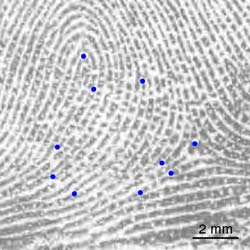Growth of adolescents’ fingerprints can be predicted

Fingerprint of a 12-year-old; specific features are marked in blue. Foto: Uni Göttingen<br>
Working in collaboration with the Federal Criminal Police Office (BKA), scientists at the University of Göttingen have developed a new procedure enabling the growth of fingerprints to be predicted. Up to now, BKA software has had difficulties in recognising that the fingerprints taken during adolescence and in adulthood were those of the same individual.
However, the error rate can be sharply reduced if the young person’s fingerprint is enlarged according to certain rules. These rules have now been determined by the researchers: the fingerprints of young persons grow evenly and in proportion to the person’s size. Their ‘pattern’ does not change significantly over the course of years. The results of the Biometrics Group at the Faculty of Mathematics and Computer Science are to be published in the journal IEEE Transactions on Information Forensics and Security.
The scientists began by investigating whether fingerprints grow in all directions evenly. “That was not completely clear from the outset, since human bones generally grow more strongly lengthwise, hence becoming narrower”, explains statistician Dr. Thomas Hotz. “But with the aid of special statistical procedures of so-called shape analysis we were able to demonstrate this.” It was then necessary to ascertain the factor by which a finger had increased in size: here it emerged that fingerprints of young people grow essentially in proportion to their body size. “We can therefore predict growth with the aid of growth tables for girls and boys”, says computer scientist Dr. Carsten Gottschlich.
Tested in practice, the methods turned out to be successful: the scientists were able to reduce the error rates of conventional fingerprint software markedly if the prints were previously enlarged by the corresponding factor. The BKA tested 48 fingerprints in a database of 3.25 million people. The software used up to now was able to assign the corresponding print of a young person in 38 cases and with the new method this was achieved in 47 cases – in one case the image quality was too poor for recognition to be possible.
In future, the BKA intends to integrate the method into its automatic fingerprint identification system (AFIS). All that is needed in order to be able to apply the growth correction is knowledge of the person’s age when the fingerprint was taken. “With the help of this method our system of handling young people’s fingerprints will be further enhanced. The joint effort has been worthwhile”, states Michael Hantschel, head of the BKA’s dactyloscopy department (AFIS) in Wiesbaden. The head of the research group at Göttingen University, Prof. Dr. Axel Munk, sees the project as a perfect example of collaboration between science and practice: “We began with a basic research question: How do fingerprints grow? With the help of modern procedures in mathematical statistics and using a BKA database we were able to answer the question. And the answer enabled us to model the growth effect in such a way that this, in turn, leads to relevant improvements in practice.”
Publication: Carsten Gottschlich, Thomas Hotz, Robert Lorenz, Stefanie Bernhardt, Michael Hantschel and Axel Munk. Modeling the Growth of Fingerprints Improves Matching for Adolescents. IEEE Transactions on Information Forensics and Security 2011. DOI: 10.1109/TIFS.2011.2143406
A preview of the article can be found on the internet at http://ieeexplore.ieee.org/xpls/abs_all.jsp?arnumber=5751684.
Contact:
Dr. Thomas Hotz
Georg-August-Universität Göttingen
Fakultät für Mathematik und Informatik
Institut für Mathematische Stochastik
Goldschmidtstraße 7, 37077 Göttingen
Tel.: +49 (0)551 39-13517, Fax +49 (0)551 39-13505
Email: hotz@math.uni-goettingen.de
Internet: http://www.stochastik.math.uni-goettingen.de
Media Contact
All latest news from the category: Information Technology
Here you can find a summary of innovations in the fields of information and data processing and up-to-date developments on IT equipment and hardware.
This area covers topics such as IT services, IT architectures, IT management and telecommunications.
Newest articles

Superradiant atoms could push the boundaries of how precisely time can be measured
Superradiant atoms can help us measure time more precisely than ever. In a new study, researchers from the University of Copenhagen present a new method for measuring the time interval,…

Ion thermoelectric conversion devices for near room temperature
The electrode sheet of the thermoelectric device consists of ionic hydrogel, which is sandwiched between the electrodes to form, and the Prussian blue on the electrode undergoes a redox reaction…

Zap Energy achieves 37-million-degree temperatures in a compact device
New publication reports record electron temperatures for a small-scale, sheared-flow-stabilized Z-pinch fusion device. In the nine decades since humans first produced fusion reactions, only a few fusion technologies have demonstrated…





















